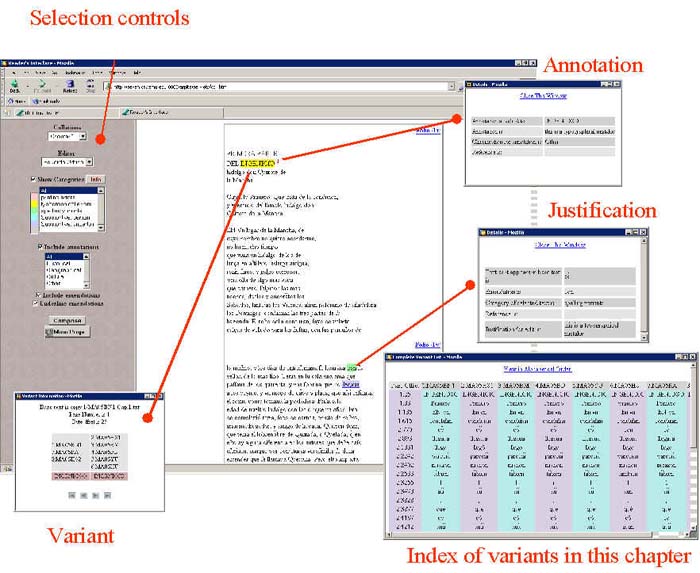| An Electronic Variorum Edition of Don Quixote |
Carlos Monroy |
![]() The creation of a
Critical Edition of Don Quixote follows these steps:
The creation of a
Critical Edition of Don Quixote follows these steps:
-
Facsimile copies of the first edition --published in 1605 and 1615--, and other significant early editions have been acquired.
-
The facsimile copies have been transcribed into text files.
-
The texts are electronically collated using the MVED (The Multi Variant Editor for Documents). To do this, one of the texts is chosen as a base text.
-
The MVED identifies all the variants (differences) between the base text and the other texts (called comparison texts). These variants are stored in a database. Scholars can then classify and justify the variants, as well as emend and annotate the texts.
-
Different abstractions of the texts can be visualized and textual analysis can be performed using ItLv (Interactive Timeline Viewer)

-
The Multi Variant Editor for Documents (MVED)
The Multi Variant Editor for Documents (MVED) is a Java application that enables users to:
-
Collate a set of texts, identifying automatically all the variants across the texts
-
Classify and justify the variants
-
Emend and annotate the text
-
Visualize texts and images simultaneously (text and images are synchronized)

Variants can be depicted either as lists (1), where each column represents one text, or as a tree (2), where each node in the tree represents a variant in the base text. Nodes can be expanded --to depict variants in the comparison texts--. All the texts used in the collation are presented in their corresponding window (3). Clicking on any entry highlights the corresponding text in the transcription (4) and (5). The text with the light blue background is the base text.

Scholars can:
- classify variants as: a) printing error, b) typographical error, c) spelling variant, d) sustantive-certain, and e) sustantive-uncertain.
- justify variants (1) and (2)
- emend and annotate the texts (3).

Texts and images are synchronized. Clicking on the image highlights the corresponding text in the transcription (1), similarly, clicking on the text, a red rectangle in the corresponding coordinates is drawn (2).
The Virtual Edition Reader's Interface (VERI)
A web-based reader's interface allows users to navigate, browse, and search the texts and images in the collection. Three different displays can be chosen: a) texts-only, b) images-only, and c) texts and images synchronized.
In the text-only display, the user is presented with the transcription. Selection controls (top) enable users to select a different edition, copy, chapter, page, or the visualization. The navigation controls (bottom) enable users to move to the next or previous page, or the first or end page of the chapter.

In the image-only display, the user is presented with the image of one page at a time. Thumbnails on the left enable users to navigate to the pages in the chapter. Selection controls (top) enable users to select a different edition, copy, chapter, page, or the visualization. The navigation controls (bottom) enable users to move to the next or previous page, or the first or end page of the chapter.

In the image-text display, the user is presented with the image of one page and its corresponding textual transcription at a time. Selection controls (top) enable users to select a different edition, copy, chapter, page, or the visualization. The navigation controls (bottom) enable users to move to the next or previous page, or the first or end page of the chapter. The image and the text are synchronized, users clicking on any given segment of the text are able to find its corresponding location in the image. Conversely, clicking on the image, its corresponding text is scrolled. A zooming option* enables users to zoom in and out the image.

The Reader's Interface also allows the user to personalize her/his own virtual critical edition. Selection controls (on the left) allow to select a collation, editor, different categories of variants, different categories of annotations (historical, geographical, cultural, other), or include emendations. Within the text, variants are highlighted in different colors, where each color corresponds to one category. Clicking on a variant, a new window pops up with all the instances of that variant in all the texts, as well as its corresponding justification. An index of variants for a chapter enables navigation through all the variants, this index can be sorted alphabetically or based on the occurrence of the variants in the text.

The Reader's Interface provides two searching options:
A simple search, the user enters the term to be search, and the results are returned in a new window.
An advanced search. The user can select among the following options:
a) characters from a panel of special characters (extended Unicode of old Spanish characters) that are not available in ASCII
b) limit the search to some of the copies in the collection
c) limit the search to some of the chapters within a copy
d) differentiate between upper and lower case
e) specify exact phrases and whole words
After pressing the search button, the results are displayed.

Search results are displayed in a list. At the top of the list, the number of occurrences of that term in each copy is depicted. Each row in the list indicates the copy, chapter, and page where that term was found, along with the line where that term appears, which is highlighted in yellow. Clicking on any of the row, a new window pops up with the section of the chapter where that entry appears, the term is also highlighted in yellow to give context. This new windows enables users to go to the previous or next page in the chapter, or to the beginning or end of the chapter. The user can select between viewing the textual transcription or the image where that term appears.


* Tilepic is and application developed a UC Berkley. -
